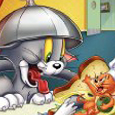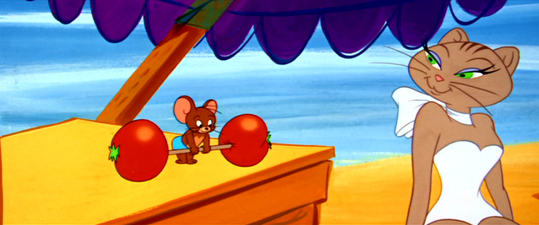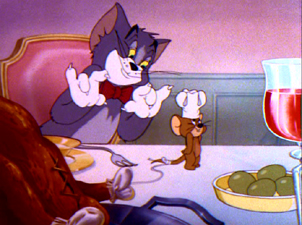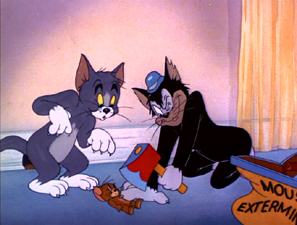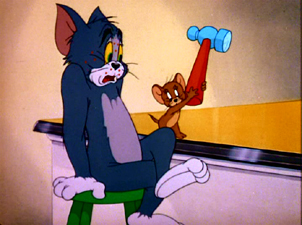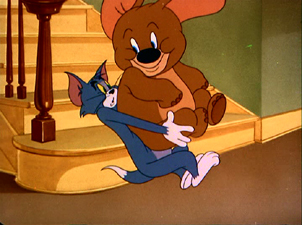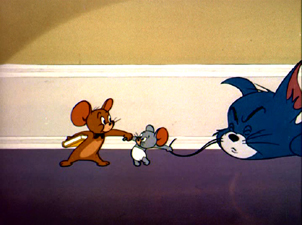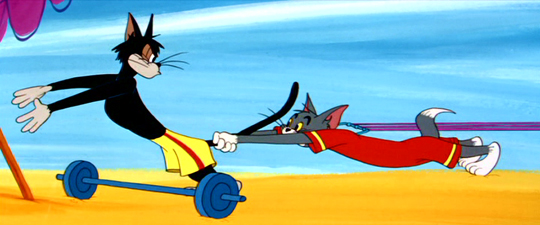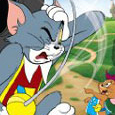Metro-Goldwyn-Mayer (1945–1956), Warner Home Video (February 2, 2010), single disc, 98 mins plus supplements, 1.33:1 and 2.37:1 aspect ratio, Dolby Digital 1.0 Mono, Not Rated, Retail: $14.98
Storyboard:
Animation’s most famous cat and mouse duo return to DVD with the fourth volume of their recent Greatest Chases collection. After two releases last year, Warner Bros. continues to repackage their classic shorts in these family-friendly single disc collections.
The Sweatbox Review:
For this fourth group of shorts, Warner Bros. has repackaged more shorts from the Tom and Jerry Spotlight Collection: Volume 2 release. Spanning over a decade of shorts, there is a great variety of shorts and it is easy to see how the series evolved over the years. Most interesting to me is how side characters and sidekicks evolved over the span of a decade. In these episodes, Tom and Jerry share the spotlight with Butch, a duckling named Quacker, Jerry’s young friend Nibbles, a baby elephant named Jumbo, a dancing bear, and Tom’s many girlfriends. While in some of the shorts, the sidekicks can be distracting, there are some of them where they serve merely as background characters (this happens most notably with Tom’s girlfriends and Mammy Two Shoes). The success of the other side characters is mixed. While Butch’s rivalry with Tom can be funny to watch (indeed, Butch is one of the most enduring T&J sidekicks), Quacker can get a bit annoying. The shorts are best when crazy chase sequences put the two main characters in perilous situations (for both Tom and Jerry). They are worst when they waste time with repetitious actions and unoriginal gags.
The shorts included on this disc are presented in the following order:
The Mouse Comes to Dinner (May 5, 1945) – At the beginning of this short, Mammy Two Shoes setting up a nice dinner on the table, but when she leaves, Tom seizes the opportunity to call his girlfriend. Jerry is then forced into serving the couple with menial tasks, but ends up rebelling and sabotaging the night for Tom. There are some good food-related gags in this short, but what is funny is seeing Tom fail miserably in impressing his date.
Springtime for Thomas (March 30, 1946) – Tom is in love with the cat next door and Jerry tries to break them up by bringing Butch into the mix. Jerry tries to coax Tom out of his trance, but Tom just doesn’t want to deal with him. Jerry then sends Butch a forged love letter that entices the alley cat to fight for the girl’s affection. Tom and Butch then fight back and forth to conquer her heart and affection with Jerry throwing a wrench into the mix. This is a fun short, but Jerry is sadly underused with Butch basically taking his place.
Trap Happy (June 29, 1946) – Butch comes back in a second cartoon on this set when Tom gets tired of chasing after Jerry on his own. Tom then calls an exterminator and for the rest of the episode both Butch and Tom try to settle the score with Jerry. They try mousetraps, magnets, explosives, and poison all in their attempts at catching Jerry. Eventually, however, they end up getting on each other’s nerves. The ending to this short is priceless and very funny. Seeing the two cats get on each other’s nerves is very entertaining.
Polka-Dot Puss (February 26, 1949) – Tom is being put outside to sleep by Mammy Two Shoes and fakes an illness in order to stay inside. When Tom goes to sleep, Jerry paints red dots on his face and then convinces Tom that he has the measles. Jerry then puts Tom through all of the treatments found in Dr. Quack’s medicine book. Each “treatment” Jerry puts Tom through becomes more extravagant than the last, and the resulting ending of this short is one of my favorites on this set.
Saturday Evening Puss (January 14, 1950) – Mammy goes out for a night on the town, leaving Tom alone to plan a party along with Butch, Lightning, and Topsy. The only problem is Jerry who is trying to sleep in his mouse hole. Jerry fights back and then all of the cats start chasing after the mouse. Even with a three-on-one advantage, of course the cats hold nothing against Jerry. By the end, Jerry does end up getting rid of the cats with one final trick up his sleeve, but even this ultimate backfires in another classic ending.
Little Quacker (January 7, 1950) – This is the debut of Quacker, a character that appears in 6 other Tom and Jerry cartoons. In the beginning of the short, Tom steals an egg from a Duck nest and is surprised when it hatches in his frying pan. Undaunted, Tom decides to make a roast duck instead. However, before Tom gets a chance to cook the duck, Jerry saves him and the duo team up against Tom as he attempts to get back to his momma duck. At first, Quacker is cute, but as a foe for Tom he is weak. He basically relies on Jerry to make decisions for him as they try to run away from Tom.
Cruise Cat (October 18, 1952) – Tom is a mascot on a cruise ship tasked with keeping the ship mouse-free. This, of course, does not stop Jerry from happily making his way on board the ship leading to many chases on the ship. In the middle of the short, Tom and Jerry make their way to the ship’s movie theater and end up watching a short of themselves in Texas Tom. To be honest, I absolutely hated seeing Texas Tom in the middle of this short. I thought it was a waste of time for the short, and really only served as filler for the story. The action literally stops halfway through the short so that we can get reaction shots from the duo as they watch Texas Tom.
The Missing Mouse (January 10, 1953) – In this short, Tom hears on the radio that a white mouse has gone missing from a nearby laboratory and that the slightest shake of the mouse could cause the city to explode. Jerry, who just had white shoe polish poured over him, realizes that he can take advantage of his situation to torment poor Tom, at least until the real missing mouse shows up. This is a fun short with Jerry at his most devilish persona as he tortures Tom into thinking he is about to blow up.
Jerry and Jumbo (February 21, 1953) – A baby elephant falls off a train and gets separated from his mom ending up inside Tom’s house. When Jumbo steals Tom’s milk, Jerry gets the blame and quickly learns of the elephant’s existence. Together, they then try to play mind games on Tom by dressing Jumbo as a giant mouse. Tom then spends the rest of the cartoon chasing after the two “mice.” While the first time Jumbo shows up as a giant mouse was funny, the gag gets overplayed for the rest of the episode with mixed results.
Just Ducky (September 5, 1953) – A mother duck watches her eggs hatch and then goes to swim with her new flock. However, the last duckling to hatch goes into the water and realizes he cannot swim. Jerry then takes it upon himself to teach the duckling how to swim. Unfortunately, the poor duck’s feeble attempts at swimming only attract the attention of Tom, who is hungry for food. Once again, Quacker is literally a sitting duck through most of the episode. He is like a damsel-in-distress that Jerry has to save from Tom.
Little School Mouse (May 29, 1954) – In this short, Jerry teaches his young pupil Nibbles how to avoid being caught by a cat. Jerry then submits Nibbles to a series of tests to show how to be careful around cats. Whenever Nibbles botches an attempt to outsmart Tom, it’s Jerry that ends up suffering the most. In the end, Jerry realizes that he can learn a lot from his pupil’s approaches. I like Nibbles and I think that he is charming in this short. Whenever he messes up, his innocence bewilders Tom before he knows what has just happened to him. I like shorts where Jerry gets knocked around a bit and that definitely happens here.
Tom and Chérie (September 9, 1955) – Jerry teaches Nibbles how to be a mouseketeer by charging him with delivering his love letters. In an attempt to show off his skills as a mouseketeer, Nibbles confronts Tom every time he steps outside the door. After finally delivering the letter to Chérie, Nibbles then has to go back and forth between the two pining lovers always facing danger of being hurt by Tom. I loved the ending of this short where Nibbles basically gives up caring about Tom’s challenges as he walks right past him without a care.
Muscle Beach Tom (September 7, 1956) – Jerry is enjoying the beach when Tom arrives with his date. At the beach, Tom must fight for the attention of his date when Butch arrives showing off his muscles. The two cats then begin to show off to Tom’s girlfriend, always trying show off in bigger ways. Even Jerry gets in on the action. The short quickly goes nowhere (although it is beautifully shot in CinemaScope). I honestly do not remember most of the gags on this short. It was really a short that shows off the skills of the animators than a tour-de-force of comedy.
Down Beat Bear (October 21, 1956) – In the final short on this set, Tom and Jerry are fighting over the radio in their living room when it is announced that a dancing bear has gone missing and there is a big reward for his capture. When the bear wanders into their home, Tom quickly grabs the telephone to call the cops, but Jerry turns the radio on causing the bear to grab Tom to dance with him. Tom and Jerry then go back and forth with the radio with Tom attempting to catch the bear while Jerry attempting to foil his plan at every turn. Most of the short relies on the funny-looking bear and his dancing with the frustrated Tom.
Is This Thing Loaded?
While there are no special features included on this set, there are trailers included for Tom and Jerry’s Greatest Chases as well as a trailer for Peanuts Valentines and Easter DVDs. The DVD also opens with a trailer for You’re a Good Man Charlie Brown.
Case Study:
The single disc set comes in a standard black keepcase with the big recycling cutout on the case. The cover features a hungry Tom looking at a Jerry sandwich. The back cover features what looks to be a scene from Cruise Cat along with a list of the fourteen episodes included in this set. There are no inserts in this set.
Ink And Paint:
There are two aspect ratios included in this short. The first 11 shorts are featured in the standard 1.33:1 aspect ratio of their original theatrical exhibitions. The final three shorts are featured in the 2.37:1 CinemaScope ratio, preserving their original ratio. The quality of the shorts varies with the older shorts containing more dust fragments and grain. The newer shorts look much more vibrant, colorful, and cleaner although they still contain some grain on the print. Still, considering these shorts are now well over 50 years old, they still look good. The quality of the shorts and the animation more than make up for any shortcomings related to the print quality. Overall, the quality is comparable to previous releases.
Scratch Tracks:
For whatever reason, once again Warner Brothers has messed up on how they advertise the audio for this release. While the back cover mentions that the DVD contains an English and Spanish track, it fails to mention that there is also a Portuguese audio track included here. As for the subtitles, it lists English and French subtitles on the back cover, but Portuguese and Thai subtitles are also included. All of the shorts are featured here with Dolby Digital 1.0 tracks.
Final Cut:
These sets must be selling well for Warner Brothers. After the long delay between volumes one and two, they have quickly reached volume four. At this rate, they will quickly cover the remaining Tom and Jerry shorts in just a few more volumes. With the first three volumes, they basically covered everything they had already released in Tom and Jerry Spotlight Collection: Volume 1, and now they are quickly working on re-releasing what was on Volume 2. As long as we do not get a repeat of Texas Tom again, I will be happy. The shorts included here may not be the most memorable Tom and Jerry shorts ever created, but they are still representative of the average Tom and Jerry short. While some episodes rely too heavily on side characters to drive the story, others shine with the interplay between the two main characters.
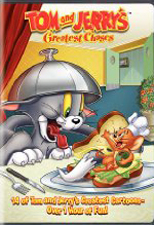 | ||
 |


